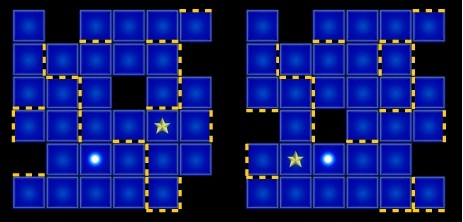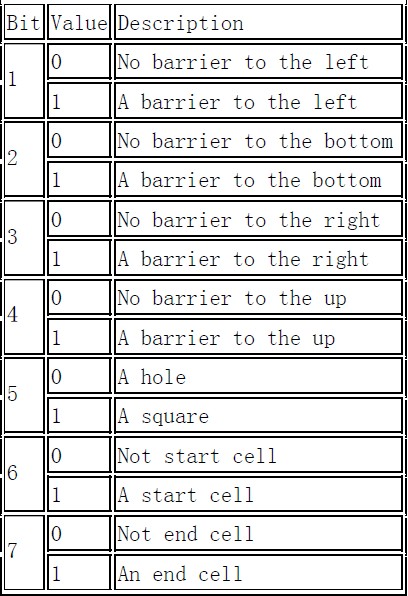HDU3713 Double Maze(BFS)
题目链接:
https://cn.vjudge.net/problem/18676/origin

A maze is made up of 6*6 cells. A cell can be either a hole or a square. Moreover, a cell may be surrounded by barriers. There is ONLY one start cell (with a ball) and ONLY one end cell (with a star) in a single maze.These two cells are both squares. It is possible that the start cell and the end cell are the same one. The goal of a single maze is to move the ball from the start cell to the end cell. There are four commands in total,'L', 'D', 'R' and 'U' corresponding to moving the ball left, down, right and up one cell, respectively. The barriers may make the commands take no effect, i.e., the ball does NOT move if there is a barrier on the way.
When the ball gets to a hole or outside of the maze, it fails. A double maze is made up of two single mazes. The commands control two balls simultaneously, and the movements of two balls are according to the rules described above independently. Both balls will continue to move simultaneously if at least one of the balls has not got to the end cell.
So, a ball may move out of the end cell since the other ball has not been to the target. A double maze passes when both balls get to their end cells, or fails if either of the two mazes fails. The goal of double maze is to get the shortest sequence of commands to pass. If there are multiple solutions, get the lexical minimum one.
To simplify the input, a cell is encoded to an integer as follows. The lowest 4 bits signal the existence of the barriers around a cell. The fifth bit indicates whether a cell is a hole or not. The sixth and seventh bits are set for the start cell and end cell. Details are listed in the following table with bits counted from lowest bit. For a barrier, both of the two adjacent cells will have the corresponding barrier bit set. Note that the first two mazes in the sample input is the encoding of two mazes in the figure above, make sure you understand the encoding right.

题目大意:
对于每两个矩阵,同时移动球,使得两个球从各自的起点到各自的终点。起始点和终点以及栅栏和黑洞的给出方式是那个数的二进制对应的位置所描述的,题目的表中有描述。
思路:
BFS即可。自己写的时候写了很久,需要注意可能因为栅栏在,而往某个方向移动移不出6*6方格外的情况,这时候判断不能以原有的方式判断是否移出去,一定要注意。
具体实现中,有栅栏就在原地呆着不动就行。
应该学习的代码:
#include<queue>
#include<cstdio>
#include<cstring>
#include<algorithm>
#include<iostream>
using namespace std;
const int N = 6;
int n, t;
char s[5] = {"DLRU"};
int f[N][N][N][N];
int nxt[4][2] = {{1,0},{0,-1},{0,1},{-1,0}};
struct maze
{int a[N][N];int bx, by, ex, ey;int d[N][N][4];void read(){for(int i = 0; i <= 5; i++)for(int j = 0; j <= 5; j++){scanf("%d", &a[i][j]);for(int k = 0; k <= 1; k++) d[i][j][k^1] = a[i][j] & (1<<k);for(int k = 2; k <= 3; k++) d[i][j][k] = a[i][j] & (1<<k);if(a[i][j]&(1<<5)) bx = i, by = j;if(a[i][j]&(1<<6)) ex = i, ey = j;a[i][j] = a[i][j] & (1<<4);}}bool check(int x, int y){return x == ex && y == ey;}bool Move(int t, int x, int y, int &xx, int &yy){if(d[x][y][t]) {xx = x; yy = y; return true;}int nx = x + nxt[t][0], ny = y + nxt[t][1];if(nx < 0 || nx > 5 || ny < 0 || ny > 5 || !a[nx][ny]) return false;xx = nx;yy = ny; return true;}
}mp[2];
struct point
{int x1, y1, x2, y2;point(int x1 = 0, int y1 = 0, int x2 = 0, int y2 = 0):x1(x1), y1(y1), x2(x2), y2(y2){};
}pre[N][N][N][N];
void output(int x1, int y1, int x2, int y2)
{if(f[x1][y1][x2][y2] == -2)return ;point p = pre[x1][y1][x2][y2];output(p.x1, p.y1, p.x2, p.y2);printf("%c", s[f[x1][y1][x2][y2]]);
}
bool bfs(maze &a, maze &b)
{queue<point> q;q.push(point(a.bx, a.by, b.bx, b.by));f[a.bx][a.by][b.bx][b.by] = -2;while(!q.empty()){point tem = q.front();q.pop();if(a.check(tem.x1, tem.y1) && b.check(tem.x2, tem.y2)){output(tem.x1, tem.y1, tem.x2, tem.y2);puts("");return true;}int x1, y1, x2, y2;for(int i = 0; i <= 3; i++){if(!a.Move(i, tem.x1, tem.y1, x1, y1)) continue;if(!b.Move(i, tem.x2, tem.y2, x2, y2)) continue;if(f[x1][y1][x2][y2] != -1) continue;f[x1][y1][x2][y2] = i;pre[x1][y1][x2][y2] = tem;q.push(point(x1, y1, x2, y2));}}return false;
}
int main()
{scanf("%d", &n);for(mp[t = 0].read(); --n; t ^= 1){memset(f, -1, sizeof(f));mp[t^1].read();if(!bfs(mp[t], mp[t^1]))printf("-1\n");}return 0;
}本弱的代码:
#include<bits/stdc++.h>
using namespace std;
struct Node
{bool dir[5];Node(){ memset(dir, false, sizeof(dir));}
}mat[2][8][8];
int nxt[4][2] = {1, 0, 0, -1, 0, 1, -1, 0};
int bx1, bx2, by1, by2, ex1, ex2, ey1, ey2;
string str[4] = {"D", "L", "R", "U"};
bool vis[6][6][6][6], flag;
void read(int t)
{int tem;for(int i = 0; i <= 5; i++)for(int j = 0; j <= 5; j++){scanf("%d", &tem);memset(mat[t][i][j].dir, false, sizeof(mat[t][i][j].dir));if(tem&(1<<1)) mat[t][i][j].dir[0] = true;if(tem&1) mat[t][i][j].dir[1] = true;if(tem&(1<<2)) mat[t][i][j].dir[2] = true;if(tem&(1<<3)) mat[t][i][j].dir[3] = true;if((tem&(1<<4)) == 0) mat[t][i][j].dir[4] = true;if(tem&(1<<5)) {bx2 = i; by2 = j;}if(tem&(1<<6)) {ex2 = i; ey2 = j;}}
}
struct Path
{int x1, y1, x2, y2;string s = "";Path(int _x1 = 0, int _y1 = 0, int _x2 = 0, int _y2 = 0):x1(_x1), y1(_y1), x2(_x2), y2(_y2){}
};
bool check(int t, int x, int y, int d)
{if(mat[t][x][y].dir[d])return true;return false;
}
bool judge(int x1, int y1, int x2, int y2)
{if(x1 == ex1 && y1 == ey1 && x2 == ex2 && y2 == ey2)return true;return false;
}
void solve(int t1, int t2)
{memset(vis, false, sizeof(vis));queue<Path> q;q.push(Path(bx1, by1, bx2, by2));vis[bx1][by1][bx2][by2] = true;bool is1, is2;while(!q.empty()){Path tem = q.front();q.pop();for(int i = 0; i <= 3; i++){is1 = is2 = false;int nx1 = tem.x1 + nxt[i][0];int ny1 = tem.y1 + nxt[i][1];int nx2 = tem.x2 + nxt[i][0];int ny2 = tem.y2 + nxt[i][1];if(check(t1, tem.x1, tem.y1, i)){nx1 = tem.x1;ny1 = tem.y1;is1 = true;}if(check(t2, tem.x2, tem.y2, i)){nx2 = tem.x2;ny2 = tem.y2;is2 = true;}if(nx1 < 0 || nx1 > 5 || ny1 < 0 || ny1 > 5 || nx2 < 0 || nx2 > 5 || ny2 < 0 || ny2 > 5)//特别要注意这个判断是在上面的判断之后continue;if(!is1 && mat[t1][nx1][ny1].dir[4])continue;if(!is2 && mat[t2][nx2][ny2].dir[4])continue;if(vis[nx1][ny1][nx2][ny2])continue;if(judge(nx1, ny1, nx2, ny2)){flag = true;cout << tem.s+str[i] << endl;return ;}vis[nx1][ny1][nx2][ny2] = true;Path aft;aft.x1 = nx1;aft.y1 = ny1;aft.x2 = nx2;aft.y2 = ny2;aft.s = tem.s + str[i];q.push(aft);}}
}
int main()
{int n, t = 0;scanf("%d", &n);for(int i = 1; i <= n; i++){bx1 = bx2;by1 = by2;ex1 = ex2;ey1 = ey2;read(t);if(i == 1){t = t^1;continue;}flag = false;if(bx1 == ex1 && by1 == ey1 && bx2 == ex2 && by2 == ey2){t = t^1;cout << endl;continue;}solve(t^1, t);t = t^1;if(!flag) puts("-1");}return 0;
}HDU3713 Double Maze(BFS)相关推荐
- 一道神坑题 POJ3026 Borg Maze BFS+prim算法
题意不说 附上链接 http://poj.org/problem?id=3026 反正先用BFS搜一遍图 记录 S和A之间的路 用一个二维数组存储 (注意 把每个S或者A 都搜一遍) 好了 剩下的就是 ...
- hdu 5094 Maze bfs
传送门:上海邀请赛E 给定一个n×m的迷宫,给出相邻格子之间的墙或者门的信息,墙说明不可走,假设是门则须要有相应的钥匙才干通过,问是否可以从(1,1)到达(n,m) 一个带状态的bfs,再另记一个状态 ...
- HDU 3713 Double Maze
题目链接:http://acm.hdu.edu.cn/showproblem.php?pid=3713 题目:两个小球同时在两个迷宫里走,求使两个小球同时到达终点的最短走法.小球不能越出迷宫界,也不能 ...
- D. Solve The Maze(BFS+思维)
Problem - 1365D - Codeforces 题意: 题意:就是有一个n*m的迷宫,里面有若干个好人(用G表示)以及若干个坏人(用B)表示,还有若干个墙(用#表示),墙的方块不能行走,人只 ...
- Borg Maze (最小生成树+bfs)
Borg Maze 题目描述: The Borg is an immensely powerful race of enhanced humanoids from the delta quadrant ...
- ACM题集以及各种总结大全(转)
ACM题集以及各种总结大全! 虽然退役了,但是整理一下,供小弟小妹们以后切题方便一些,但由于近来考试太多,顾退役总结延迟一段时间再写!先写一下各种分类和题集,欢迎各位大牛路过指正. 一.ACM入门 关 ...
- 4kyu Path Finder #2: shortest path
4kyu Path Finder #2: shortest path 题目背景: Task You are at position [0, 0] in maze NxN and you can onl ...
- 4kyu Path Finder #1: can you reach the exit?
4kyu Path Finder #1: can you reach the exit? 题目背景: Task You are at position [0, 0] in maze NxN and y ...
- 数据结构实习-迷宫(基于Qt实现)
预览效果: Maze.pro文件 1 #------------------------------------------------- 2 # 3 # Project created by QtC ...
最新文章
- 利用逻辑回归进行简单的人群分类解决广告推荐问题
- W3C DOM操作之创建新节点
- 【Java从入门到天黑|04】JavaSE入门之数组
- Centos 7.x 内核升级
- visio画图复制粘贴到word_visio复制粘贴到word中
- Pytorch搭建网络模型
- 测评EasyRecovery的数据恢复效果与多种功能
- 合并的表格怎么加横线_怎么在表格中加一横线
- 你必须掌握的人生定律
- “万米网格管理法”助力省城城市管理
- SQLserver提供的统计信息流已损坏
- 达拉斯大学计算机硕士专业排名,德克萨斯大学达拉斯分校UTD计算机科学Computer Science专业排名第251-300位(2021年THE世界大学商科排名)...
- 两个时间之间的有多少个工作日,有多少天,有多少天的周末
- 讲座录播及课件|Tamer Özsu教授:图处理-全景式视角和开放性问题
- 关于ElasticSearch (ES)
- 衡量子空间相似度和距离的主角 principal angles
- MySQL如何同时删除主外键关联的两张表中的数据
- css实现箭头上下跳动动画
- iEx.ec演示DApp的初步了解,快来“尝鲜”iEx.ec分布式云的强大算力
- 一个编得好的拼音输入法C51的
